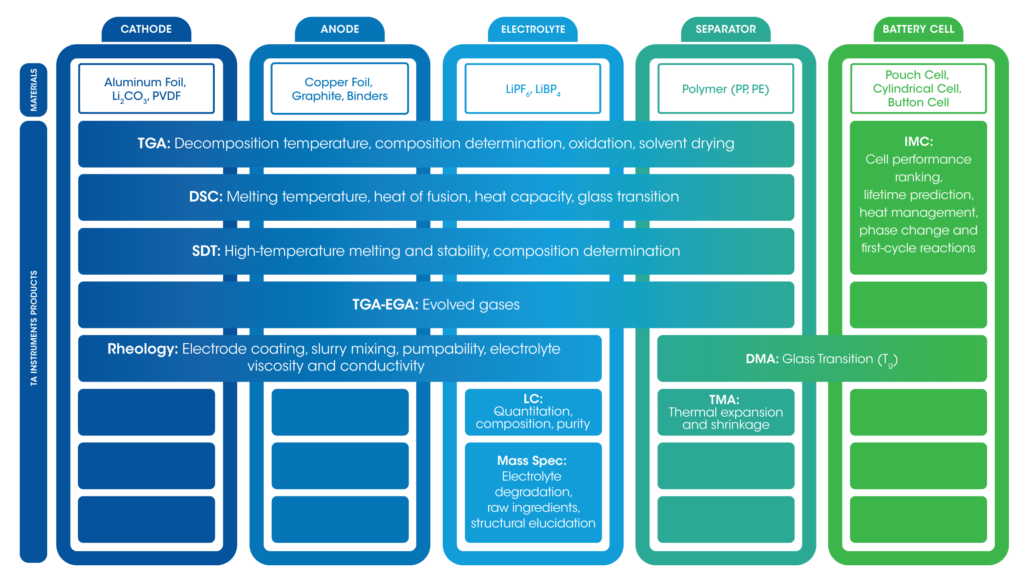[av_section min_height=’custom‘ min_height_pc=’25‘ min_height_px=’120px‘ padding=’small‘ margin=’aviaTBmargin‘ custom_margin=’20px,10px‘ color=’alternate_color‘ background=’bg_color‘ custom_bg=’#00a4d6′ background_gradient_color1=“ background_gradient_color2=“ background_gradient_direction=’vertical‘ src=“ attachment=“ attachment_size=“ attach=’scroll‘ position=’top left‘ repeat=’no-repeat‘ video=“ video_ratio=’16:9′ overlay_opacity=’0.5′ overlay_color=“ overlay_pattern=“ overlay_custom_pattern=“ shadow=’no-border-styling‘ bottom_border=’no-border-styling‘ bottom_border_diagonal_color=’#333333′ bottom_border_diagonal_direction=“ bottom_border_style=“ custom_arrow_bg=“ id=“ custom_class=“ aria_label=“ av_element_hidden_in_editor=’0′ av_uid=’av-jqqcuwc1′]
[av_textblock size=’20‘ av-medium-font-size=“ av-small-font-size=“ av-mini-font-size=“ font_color=’custom‘ color=’#ffffff‘ id=“ custom_class=“ av_uid=’av-jqqcn7zg‘ admin_preview_bg=“]
TA Instruments: „Spannende Zeiten in der Batterieforschung“
[/av_textblock]
[/av_section]
[av_image src=’https://battery-news.de/wp-content/uploads/2022/06/2022-03-NUR-Batteries-and-Battery-Materials.Infographic-Email-1030×584.png‘ attachment=’12568′ attachment_size=’large‘ copyright=’icon-reveal‘ caption=“ styling=“ align=’center‘ font_size=“ overlay_opacity=’0.4′ overlay_color=’#000000′ overlay_text_color=’#ffffff‘ animation=’no-animation‘ hover=“ appearance=“ lazy_loading=’disabled‘ link=“ target=“ title_attr=“ alt_attr=“ id=“ custom_class=“ av_element_hidden_in_editor=’0′ av_uid=’av-jxf0aa6o‘ admin_preview_bg=’rgb(255, 255, 255) none repeat scroll 0% 0%‘][/av_image]
[av_tab_section initial=’1′ tab_pos=’av-tab-above-content‘ content_height=’av-tab-content-auto‘ tab_padding=’small‘ padding=’small‘ bg_color=’#00a4d6′ color=’#ffffff‘ transition=’av-tab-no-transition‘ id=“ custom_class=“ aria_label=“ av_element_hidden_in_editor=’0′ av_admin_tab_active=’1′ av_uid=’av-kzpsx3hk‘]
[av_tab_sub_section tab_title=“ icon_select=’image_top‘ icon=’ue800′ font=’entypo-fontello‘ tab_image=’10780′ tab_image_style=’av-tab-image-rounded‘ vertical_align=’top‘ color=“ background_color=“ src=“ attachment=“ attachment_size=“ background_attachment=’scroll‘ background_position=’top left‘ background_repeat=’no-repeat‘ custom_class=“ av_uid=’av-kzpswd3d‘]
[av_one_full first min_height=“ vertical_alignment=’av-align-top‘ space=“ row_boxshadow_color=“ row_boxshadow_width=’10‘ custom_margin=’aviaTBcustom_margin‘ margin=’10px‘ margin_sync=’true‘ mobile_breaking=“ border=“ border_color=“ radius=’0px‘ radius_sync=’true‘ padding=’0px‘ padding_sync=’true‘ column_boxshadow_color=“ column_boxshadow_width=’10‘ background=’bg_color‘ background_color=“ background_gradient_color1=“ background_gradient_color2=“ background_gradient_direction=’vertical‘ src=“ attachment=“ attachment_size=“ background_position=’top left‘ background_repeat=’no-repeat‘ highlight_size=’1.1′ animation=“ link=“ linktarget=“ link_hover=“ title_attr=“ alt_attr=“ mobile_display=“ id=“ custom_class=“ aria_label=“ av_uid=’av-4so6′]
[av_textblock size=’14‘ av-medium-font-size=“ av-small-font-size=“ av-mini-font-size=“ font_color=’custom‘ color=’#000000′ id=“ custom_class=“ av_uid=’av-jqqkcgkn‘ admin_preview_bg=“]
Autoren: Die Redaktion
Veröffentlicht am 03.06.2022
[/av_textblock]
[/av_one_full][av_one_full first min_height=’av-equal-height-column‘ vertical_alignment=’av-align-middle‘ space=’no_margin‘ row_boxshadow_color=“ row_boxshadow_width=’10‘ margin=’0px‘ margin_sync=’true‘ mobile_breaking=“ border=“ border_color=“ radius=’0px‘ radius_sync=’true‘ padding=’0px‘ padding_sync=’true‘ column_boxshadow_color=“ column_boxshadow_width=’10‘ background=’bg_color‘ background_color=“ background_gradient_color1=“ background_gradient_color2=“ background_gradient_direction=’vertical‘ src=“ attachment=“ attachment_size=“ background_position=’top left‘ background_repeat=’no-repeat‘ highlight_size=’1.1′ animation=“ link=“ linktarget=“ link_hover=“ title_attr=“ alt_attr=“ mobile_display=“ id=“ custom_class=“ aria_label=“ av_uid=’av-kzpxzaoc‘]
[av_textblock size=“ av-medium-font-size=“ av-small-font-size=“ av-mini-font-size=“ font_color=’custom‘ color=’#000000′ id=“ custom_class=“ av_uid=’av-jqb3bj28′ admin_preview_bg=“]
Wie kann die Herstellung von leistungsstärkeren und sichereren Lithium-Ionen-Akkus gelingen? Wie lassen sich Slurrys so optimieren, dass eine gleichmäßige, glatte Beschichtung möglich ist? Im Interview zeigt das weltweit agierende Unternehmen Waters | TA Instruments mit deutschem Sitz in Eschborn, wie es die Batterieforschung und Produktionsingenieur:innen bei ihrer Arbeit unterstützen kann.
Battery-News.de: Seit wann ist Ihr Unternehmen im Bereich der Batteriezellenfertigung tätig – und wie hat sich dieser Bereich in den vergangenen Jahren entwickelt?
Waters | TA Instruments: Wir sind seit vielen Jahren in der Materialprüfung von Batterien aktiv. Obwohl Waters | TA Instruments keine Batteriezellen herstellt, bieten wir fortschrittliche Analyse-Instrumente an, mit denen wir Materialwissenschaftler:innen, Elektrochemiker:innen, Batterieforscher:innen und andere dazu befähigen, Materialien zu erstellen, zu entwickeln und auszuwählen, die in Lithium-Ionen-Batteriezellen zum Einsatz kommen. Bis vor kurzem konzentrierte sich der Großteil der Batterieentwicklung auf China, Japan und Südkorea. Verschiebungen in der Lieferkette aufgrund der Corona-Pandemie haben in den US-amerikanischen und europäischen Märkten jedoch die Notwendigkeit verstärkt, eigene Entwicklungen zu fördern. Infolgedessen ist der globale Batteriemarkt in den vergangenen Jahren um 20 bis 30 Prozent jährlich gewachsen.
Battery-News.de: Wie sehen aktuelle Anwendungen von Waters-Produkten in der Batterieindustrie aus?
Waters | TA Instruments: Wir konzentrieren uns in erster Linie darauf, Batterieforscher:innen dabei zu helfen, leistungsstärkere und sicherere Lithium-Ionen-Akkus herzustellen. Dazu verfügen wir über analytische Instrumente, die es ermöglichen, die Hitzetoleranz der Materialien zu verstehen, die in die Kathode, die Anode, den Elektrolyten, das Bindemittel und den Separator gelangen. Wir bieten auch Rheologielösungen an, die Produktionsingenieur:innen über Slurrys informieren, die in die Kathode, die Anode und den Elektrolyten gelangen. Die Rheologie hilft bei der Entwicklung optimierter Slurrys, in denen sich die Partikel während der Herstellung nicht absetzen, was eine gleichmäßige, glatte Beschichtung ermöglicht.
Battery-News.de: Welcher Prozessschritt stellt das höchste Risiko beziehungsweise die größte Herausforderung dar, wenn man die übliche Produktionskette betrachtet?
Waters | TA Instruments: Wir glauben, dass das größte Risiko für gut funktionierende Batterien in der Hitzetoleranz besteht. Im Betrieb, insbesondere in Elektrofahrzeugen, verfügen Lithium-Ionen-Batterien normalerweise über ein Wärmemanagementsystem, um sicherzustellen, dass die Akkus innerhalb des Batteriemoduls in einem optimalen Temperaturbereich bleiben. Üblicherweise bewegt sich dieser Wert zwischen 20 und 40 Grad Celsius, aber prinzipiell müssen die Materialien einem Bereich von minus 20 bis plus 60 Grad standhalten. Sobald die Batterie diesen Temperaturbereich verlässt – vor allem am oberen Ende –, kann das zu einer Überhitzung führen. Dieses thermische Durchgehen beginnt normalerweise an der Festkörper-Elektrolyt-Grenzfläche und kaskadiert auf andere Komponenten der Batterie. Geht dieser „Thermal Runaway“ unkontrolliert vonstatten, kann es zu einem katastrophalen Ausfall führen, etwa zu einem Brand. Instrumente der thermischen Analyse können Batterieforscher:innen dabei helfen, die Wärmetoleranz von Materialien zu verstehen – zum Beispiel, wenn ein Material schmilzt oder es sich zersetzt und wie gut verschiedene Systeme innerhalb einer Batteriezelle Wärme an die Wärmesenken abgeben können. Ein effektives Wärmemanagementsystem kann die Batterie im optimalen Temperaturbereich halten, was eine sichere Leistung ermöglicht und gefährliche thermische Instabilitäten vermeidet.
[/av_textblock]
[av_image src=’https://battery-news.de/wp-content/uploads/2022/06/DSC_Dx3_Beauty-Right.jpg‘ attachment=’12569′ attachment_size=’full‘ copyright=“ caption=“ styling=“ align=’center‘ font_size=“ overlay_opacity=’0.4′ overlay_color=’#000000′ overlay_text_color=’#ffffff‘ animation=’no-animation‘ hover=“ appearance=“ lazy_loading=’disabled‘ link=“ target=“ title_attr=“ alt_attr=“ id=“ custom_class=“ av_element_hidden_in_editor=’0′ av_uid=’av-l3x59zmd‘ admin_preview_bg=“][/av_image]
[av_textblock size=“ av-medium-font-size=“ av-small-font-size=“ av-mini-font-size=“ font_color=’custom‘ color=’#000000′ id=“ custom_class=“ av_uid=’av-jqb3bj28′ admin_preview_bg=“]
Battery-News.de: Welches Ihrer Produkte reduziert dieses Risiko, und wie funktioniert dieses Gerät?
Waters | TA Instruments: Thermogravimetrische Analyse (TGA) ist im Grunde eine analytische Waage in einem Ofen. Wird eine Probe in eine TGA gegeben, kann diese Probe aufgrund von Reaktionen mit Sauerstoff in der Atmosphäre – also durch Oxidation – an Gewicht zunehmen. Sie kann aber durch Materialzersetzung auch an Gewicht verlieren. TGA liefert die Temperatur, bei der Batteriematerialien oxidieren oder sich zersetzen. Die „Differential Scanning Calorimetry“ – kurz: DSC, oder auf deutsch: Dynamische Differenzkalorimetrie – misst den Wärmestrom einer Probe im Vergleich zu einer Referenz und gibt dadurch Einblicke in endotherme und exotherme Prozesse. DSC ermöglicht es Forscher:innen zu verstehen, wann Materialien schmelzen, kristallisieren und Glasübergänge durchlaufen. Erkenntnisse aus TGA und DSC versetzen Batterieentwickler:innen in die Lage, Kathoden, Anoden, Separatoren, Binder und Elektrolyte auszuwählen, die die erforderlichen Wärmetoleranzen für die jeweilige Anwendung aufweisen.
Battery-News.de: Wie unterscheidet sich dieses Produkt technologisch von denen anderer Wettbewerber?
Waters | TA Instruments: Viele unserer Instrumente setzen den Industriestandard für ihre Tests, und einige unserer Instrumente bieten einzigartige Testbereiche und -funktionen, mit denen kein anderes derzeit auf dem Markt existierendes System konkurrieren kann. Neben der Auswahl des besten Instruments müssen sich viele Batterieentwickler:innen zunächst mit diesen Charakterisierungstechniken vertraut machen. Das Team von TA Instruments verfügt über Branchenexpert:innen, die unsere Anwender:innen bei der Batterieentwicklung unterstützen, und wir stellen der Community kostenfreie Online-Ressourcen zur Verfügung, um Batterieentwickler:innen dabei zu helfen, leistungsfähigere, langlebigere und sicherere Akkus herzustellen.
[/av_textblock]
[av_image src=’https://battery-news.de/wp-content/uploads/2022/06/Anode-Cathode-graphic-1030×865.png‘ attachment=’12570′ attachment_size=’large‘ copyright=“ caption=“ styling=“ align=’center‘ font_size=“ overlay_opacity=’0.4′ overlay_color=’#000000′ overlay_text_color=’#ffffff‘ animation=’no-animation‘ hover=“ appearance=“ lazy_loading=’disabled‘ link=“ target=“ title_attr=“ alt_attr=“ id=“ custom_class=“ av_element_hidden_in_editor=’0′ av_uid=’av-l3x59zmd‘ admin_preview_bg=“][/av_image]
[av_textblock size=“ av-medium-font-size=“ av-small-font-size=“ av-mini-font-size=“ font_color=’custom‘ color=’#000000′ id=“ custom_class=“ av_uid=’av-jqb3bj28′ admin_preview_bg=“]
Battery-News.de: Wie sehen Sie die Entwicklung zukünftiger Zelltechnologien, insbesondere im Hinblick auf Festkörperbatterien und Trockenbeschichtungen?
Waters | TA Instruments: Es gibt viele Optionen für künftige Zelltechnologien, die einzigartige Probleme lösen: Festkörperbatterien, um den organischen Elektrolyten zu eliminieren, feste Lithiumanoden zur Erhöhung der Batterieenergiedichte, Natrium-Ionen-Batterien als Weg, um von Seltenerdmetallen und zahlreichen anderen Rohstoffen wegzukommen. Die Anzahl der Optionen für zukünftige Batteriezellentechnologien bedeutet, dass Batterieforscher:innen und -entwickler:innen eine noch umfassendere Charakterisierung des Batteriematerials benötigen, um zu beweisen, dass ihr Design frühere Modelle übertrifft. Wenn neue Designs entstehen, müssen Batterieingenieur:innen sicherstellen, dass die Wärmetoleranzen ihrer Batteriematerialien und die Homogenität der Slurrys die Industriestandards einhalten. Daher bringt die Erforschung neuer Zelltechnologien eine spannende Zeit für die Materialwissenschaften in der Batterieentwicklung mit sich.
[/av_textblock]
[/av_one_full][/av_tab_sub_section][av_tab_sub_section tab_title=“ icon_select=’image_top‘ icon=’ue800′ font=’entypo-fontello‘ tab_image=’10779′ tab_image_style=’av-tab-image-circle‘ vertical_align=’middle‘ color=“ background_color=“ src=“ attachment=“ attachment_size=“ background_attachment=’scroll‘ background_position=’top left‘ background_repeat=’no-repeat‘ custom_class=“ av_uid=’av-kzpsy3wk‘]
[av_textblock size=’14‘ av-medium-font-size=“ av-small-font-size=“ av-mini-font-size=“ font_color=’custom‘ color=’#000000′ id=“ custom_class=“ av_uid=’av-jqqkcgkn‘ admin_preview_bg=“]
Authors: Editorial staff
Published 3rd June, 2022
[/av_textblock]
[av_one_full first min_height=“ vertical_alignment=“ space=“ row_boxshadow=“ row_boxshadow_color=“ row_boxshadow_width=’10‘ custom_margin=“ margin=’0px‘ mobile_breaking=“ border=“ border_color=“ radius=’0px‘ padding=’0px‘ column_boxshadow=“ column_boxshadow_color=“ column_boxshadow_width=’10‘ background=’bg_color‘ background_color=“ background_gradient_color1=“ background_gradient_color2=“ background_gradient_direction=’vertical‘ src=“ background_position=’top left‘ background_repeat=’no-repeat‘ highlight=“ highlight_size=“ animation=“ link=“ linktarget=“ link_hover=“ title_attr=“ alt_attr=“ mobile_display=“ id=“ custom_class=“ aria_label=“ av_uid=’av-wdzkt3′]
[av_textblock size=’14‘ av-medium-font-size=“ av-small-font-size=“ av-mini-font-size=“ font_color=’custom‘ color=’#000000′ id=“ custom_class=“ av_uid=’av-jqqkcgkn‘ admin_preview_bg=“]
Battery-News.de: How long has Waters been active in the field of battery cell production – and how has this area grown in recent years?
Waters | TA Instruments: Waters | TA Instruments has been active in battery material testing for many years. Although Waters | TA Instruments does not produce battery cells, we provide advanced analytical instrumentation to empower material scientists, electrochemists, battery researchers, etc. to successfully create, develop, and select materials that go into lithium-ion battery cells. Until recently, most of the battery development has focused in China, Japan, and South Korea. However, due to supply-chain dislocations due to COVID-19, the US and European markets have put more attention on developing in-country expertise. As a result, the global battery market has been growing 20-30% per year in recent years.
Battery-News.de: What are the current applications of Waters products in the battery industry?
Waters | TA Instruments: Waters | TA Instruments primarily focuses on helping battery researchers produce better performing and safer lithium-ion batteries. We provide analytical instrumentation that allows researchers to understand the heat tolerance of the materials going into the cathode, anode, electrolyte, binder, and separator. Waters | TA Instruments also offers rheology solutions that inform production engineers about slurries that go into the cathode, anode, and electrolytes. Rheology helps them develop optimized slurries in which the particles don’t settle during manufacturing, allowing for uniform, smooth coating.
Battery-News.de: In your opinion, which process step represents the greatest risk or challenge when considering the usual production chain?
Waters | TA Instruments: We believe the greatest risk to well-functioning batteries is heat tolerance. In operation, especially in EV’s, lithium-ion batteries usually have a thermal management system to ensure that the batteries inside the battery module stay within an optimal temperature range. Usually this optimal temperature is 20 – 40 C, but the materials usually need to withstand a range of -20 C to 60 C. Once the battery gets outside of this temperature range, especially at the upper end, it can lead to something called thermal runaway. Thermal runaway usually begins at the solid electrolyte interface and cascades to other components of the battery. If this event is uncontrolled, it can lead to a catastrophic failure such as a fire. Thermal analysis instrumentation can help battery researchers understand heat tolerance of materials, e.g., when a material melts, decomposes, etc. and how well different systems within a battery cell can diffuse heat to the thermal sinks. An effective thermal management system can keep the battery within the optimal temperature range, enabling safe performance and avoiding dangerous thermal runaway events.
Battery-News.de: Which of your products reduces this risk and how does this device work?
Waters | TA Instruments: Thermal gravimetric analysis (TGA) is basically an analytical balance inside of an oven. When a sample is placed in a TGA, the sample can gain weight due to reactions with oxygen in the atmosphere, i.e., oxidation, or it can lose weight when the material decomposes. TGA provides the temperature at which battery materials oxidize or decompose. Differential Scanning Calorimetry (DSC) measures the heat flow of a sample compared with a reference thereby giving insights into endothermic and exothermic processes. DSC allows researchers to understand when materials melt, crystalize, and undergo glass transitions. Insights gained from TGA and DSC allow battery developers to select cathode, anode, separators, binder, and electrolytes that have the necessary heat tolerances for the application.
Battery-News.de: How does this product differ technologically from those of any competitors?
Waters | TA Instruments: Waters | TA Instruments offers thermal analysis and rheology systems with the best performance specifications and superior service. Many of our instruments set the industry standard for their tests, and some of our instruments offer unique testing ranges and capabilities that no other system on the market can compete with. In addition to choosing the best instrument, many battery developers must first become familiar with these characterization techniques. The Waters | TA Instruments team has industry experts to support our battery development users, and we are contributing free online resources to the community to help battery developers make better performing, longer lasting, and safer batteries.
Battery-News.de: How do you see the development of future cell technologies, especially when considering solid-state batteries and dry coatings?
Waters | TA Instruments: There are many options for future cell technologies that solve unique issues. Solid state batteries to eliminate the organic electrolyte. Solid lithium anodes to increase battery energy density. Sodium-ion batteries as a way to get away from rare-earth metals and many others. The number of options for future battery cell technologies means that battery researchers and developers will need even greater battery material characterization to prove that their design outperforms previous models. As new designs emerge, battery engineers must ensure that their battery materials’ heat tolerances and slurries’ uniformity maintain industry standards. So the exploration of new cell technologies is an exciting time for material science in battery research and development.
[/av_textblock]
[/av_one_full][/av_tab_sub_section][/av_tab_section][av_hr class=’invisible‘ height=’50‘ shadow=’no-shadow‘ position=’center‘ custom_border=’av-border-thin‘ custom_width=’50px‘ custom_border_color=“ custom_margin_top=’30px‘ custom_margin_bottom=’30px‘ icon_select=’yes‘ custom_icon_color=“ icon=’ue808′ font=’entypo-fontello‘ av_uid=’av-jtfk6jks‘ admin_preview_bg=“]
[av_social_share title=’Artikel teilen‘ style=“ buttons=“ av_uid=’av-jte46m4z‘ admin_preview_bg=“]
[av_hr class=’invisible‘ height=’50‘ shadow=’no-shadow‘ position=’center‘ custom_border=’av-border-thin‘ custom_width=’50px‘ custom_border_color=“ custom_margin_top=’30px‘ custom_margin_bottom=’30px‘ icon_select=’yes‘ custom_icon_color=“ icon=’ue808′ font=’entypo-fontello‘ av_uid=’av-jtfk6jks‘ admin_preview_bg=“]
[av_hr class=’invisible‘ height=’50‘ shadow=’no-shadow‘ position=’center‘ custom_border=’av-border-thin‘ custom_width=’50px‘ custom_border_color=“ custom_margin_top=’30px‘ custom_margin_bottom=’30px‘ icon_select=’yes‘ custom_icon_color=“ icon=’ue808′ font=’entypo-fontello‘ av_uid=’av-jtfk6jks‘ admin_preview_bg=“]
[av_postslider link=’post_tag‘ wc_prod_visible=“ prod_order_by=“ prod_order=“ columns=’3′ items=’30‘ offset=’0′ contents=’title‘ preview_mode=’auto‘ image_size=’portfolio‘ autoplay=’yes‘ interval=’5′ av_uid=’av-juv3xr0v‘]




